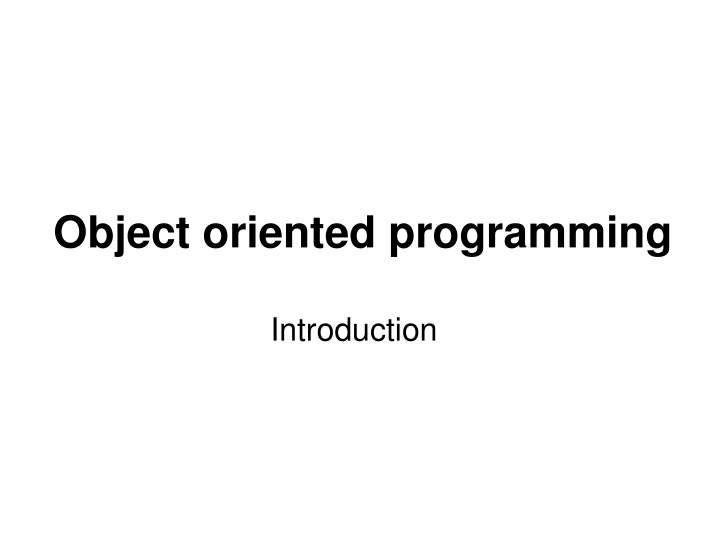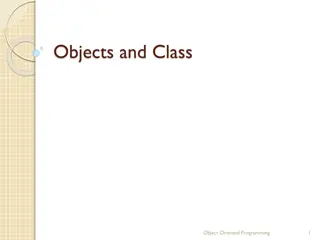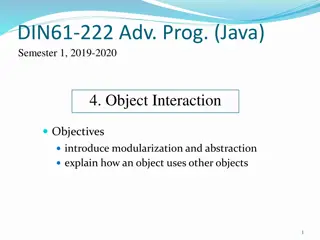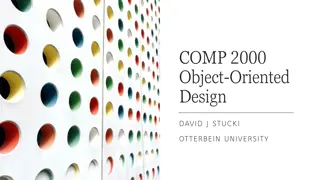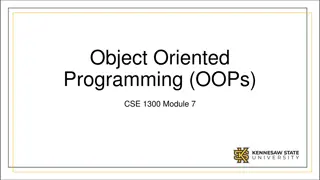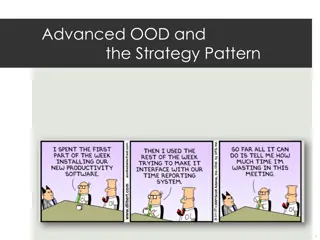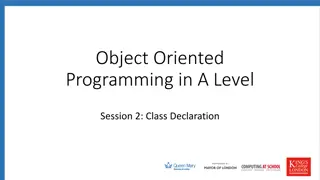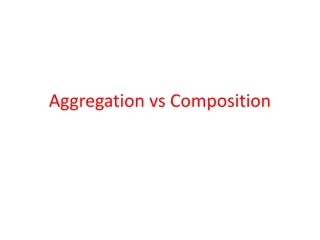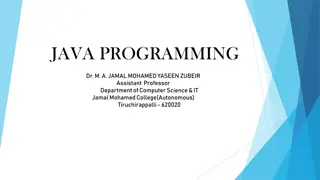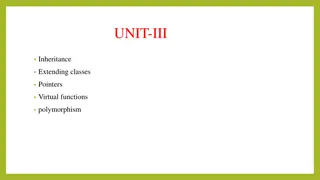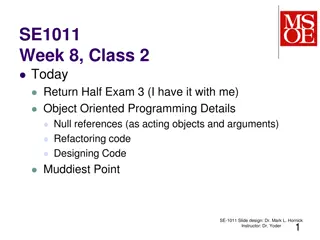Object oriented programming
Ancient programming styles involving imperative programming gave way to structured programming before transitioning to the robust and versatile object-oriented programming paradigm. This evolution facilitated the representation of complex data structures and real-world objects efficiently. Object-oriented programming emerged in the 1970s and evolved through languages like Smalltalk, C++, Java, and Python, revolutionizing the way software is developed and maintained.
Download Presentation

Please find below an Image/Link to download the presentation.
The content on the website is provided AS IS for your information and personal use only. It may not be sold, licensed, or shared on other websites without obtaining consent from the author.If you encounter any issues during the download, it is possible that the publisher has removed the file from their server.
You are allowed to download the files provided on this website for personal or commercial use, subject to the condition that they are used lawfully. All files are the property of their respective owners.
The content on the website is provided AS IS for your information and personal use only. It may not be sold, licensed, or shared on other websites without obtaining consent from the author.
E N D
Presentation Transcript
Object oriented programming Introduction
Imperative programming style classic programming style used in 60th 70thwhen the first high-level programming languages were created the nub: create algorithms over (relatively) simple data (arrays, text, stuctures, ...), data plays second role algorithms corresponds to mathematical formulation (abstraction) of the problem
decomposition is used problem decomposition into simpler sub- problems top down design sub-problems are solved in procedures/functions (structured programming) suitable for mathematical tasks the first applicable domain for computers
structured programming, simple data structures and classic approach were not enough when computers were applied in new areas like modeling, simulation, databases it was difficult to describe real word objects and relationships among them (generalization, specialization) Good approach is object oriented style ...
Object oriented programming (OOP) originated in 70th Smalltalk clear object oriented language Simula67 object oriented language for simulations rapid development in 80thand in 90th embedded into C - creation of C++ (1983), Pascal, Visual Basic, Java, C# OOP is a part of php, Python,
Structure to represent complex numbers non OOP approach header file complex.h typedef struct { float re,im; //real and imaginary parts } Complex; // function returns abs. value of complex number float abs_val(Complex &c);
Structure to represent complex numbers non OOP approach file complex.c float abs_val(Complex &c) { return sqrt(c.re*c.re+c.im*c.im); } data and operations are separated
Structure to represent complex numbers non OOP approach #include "complex.h" void main() { Complex c1,c2; c1.re = 4; c1.im = 3; c2.re = 0; c2.im = 0; cout << "Real part of c1 is " << c1.re << endl; cout << "Imagin. part of c1 is " << c1.im << endl; cout << "Abs. value of c1 is " << abs_val(c1) << endl; }
Object oriented programming style One of many definitions: Object oriented programming style is a general process od analysis, design and implementation of program based on direct modeling (description) of real-world objects in world of computers using abstraction and hierarchization
data structure called object (in program) is a model of the object in the real word object is characterized with: piece of information about object (data) implemented as data structures (imagine variables) - attributes in OOP terminology operations processed with attributes (realized by procedures and functions - methods in OOP terminology own activity is implemented sometimes - threads in JAVA
attributes and methods are closely bound (syntactically and semantically); object is an encapsulation of attributes and methods objects communicate each other by calling methods (= pass messages)
Object oriented analyses simplify: OOA is based on searching object and relationships among them in the real world object: a pair (D,F): D - attributes, F - methods we identify attributes and describe them by names (identifiers) and data types we describe methods by name, their behavior informally by words firstly, then formally for example by state machine
exception and errors should be also described output of OOA is some structure diagram (e.g. Codad's notation see below, class diagram in UML) or objects definitions written in programming language or ODL (Object Definition Language) Object 1 attributes methods Object 2 atributes methods 1 n
Object oriented analyses data and list of methods are designed firstly, detailed algorithm after
special instruments of Object Oriented Approach: inheritance some object (child) inherits features (attributes and methods) from another object (parent) specialization it is possible to redefine methods of define new additional attributes and methods polymorphism the same syntax for several elements implemented by overloading methods and operators (remember operators <<, >>) genericity
OOP in C++ class - new data type to describe object in C++ best practice: classes are declared usually in header files .h, implementation of methods are in separate files .cpp it is not needles to declare new type using typedef
class declaration in header files: class Class_name { list of attributes; list of methods; }; good practice: guard block is usually included in header file to prevent compile error "redefinition of "
File headerfile1.h class A { ... }; File headerfile2.h #include "headerfile1.h" class B { ... }; File headerfile3.h #include "headerfile1.h" class C { ... };
Main #include "headerfile2.h" #include "headerfile3.h" Problem: headerfile1.h is twice included compiler prints error like "redefinition of class A" int main() { ... };
File headerfile1.h correctly: #ifndef HEADERFILE1H #define HEADERFILE1H class A { ... }; #endif most tools (Codeblocks too) insert automatically this guard block
Example: Design class to represent complex number class declaration is in file complex.h
#ifndef COMPLEXH #define COMPLEXH class Complex { float re,im; //real and imag. parts float abs_value(); }; #endif attributes methods
Methods implementation implementation is usually in the separate .cpp file type Class_name::method(parameters) { body (code) }
complex.cpp file with implementation: #include "complex.h floatComplex::abs_value() { return sqrt(re*re+im*im); }
NO OBJECT is created if a class is declared and methods are implemented! The Class is only definition of the new date type, CLASS is a DESCRIPTION OF OBJECT, i.e. Information for the compiler how to create object ! The OBJECT is a variable of class data type (object = class instance).
How to use the class Complex? #include "complex.h void main() { Complex c1,c2; c1.re = 4; c1.im = 3; c2.re = 0; c2.im = 0; cout << "The real part of c1 is " << c1.re; cout << "Abs.val. of c1 is " << c1.abs_value() << endl; } the method abs_val () over the object c1 is called here Compiler prints error there two variables c1, c2 are created two object c1, c2 (instances of Complex class)
Why does the error occurs? attributes and methods are automatically private, i.e. it is possible to manipulate with them only inside member functions (methods) two ways to solve: declare (some) attributes and methods as public define public methods reading/writing from/to attributes
Control visibility of attributes and methods: private it is possible to manipulate with attributes / to call methods only in member functions public manipulation possible everywhere protected similar to private, used in context of inheritance; manipulation possible only in member functions and in children
#ifndef COMPLEXH #define COMPLEXH class Complex { public: float re,im; //real and imag parts float abs_value(); }; #endif
How to use the class Complex? #include "complex.h void main() { Complex c1,c2; c1.re = 4; c1.im = 3; c2.re = 0; c2.im = 0; cout << "The real part of c1 is " << c1.re; cout << "Abs.val. of c1 is " << c1.abs_value() << endl; } The code is compillable now
Notes to visibility control privates attributes and methods are useful example: the value of the attribute represents some object state and it is not desirable to change the value "outside" of the object (purposely or by mistake) the set is implemented by object oriented programming and one attribute is a count of elements in set; it is evident that the value of this attribute shall be changed only when new element is inserted/some element removed i.e. in methods insert/remove
some helpful methods are declared as private list of public methods composes class interface if the value of the private attribute is desirable to read, public method with typical prefix get_, resp. read_, e.g. float get_img() is defined returning attribute value
if the value of the private attribute is desirable to set, public method with typical prefix set_, resp. writeis defined setting attribute value e.g. void set_img(float imag) it useful to declare private attributes if the set of acceptable values is limited; the public method set_ can check if setting value is not out of range
complex.h #ifndef COMPLEXH #define COMPLEXH class Complex { private: float re,im; //real and imag. parts public: float get_real(); float get_img(); void set_real(float real); void set_img(float imag); float abs_val(); }; #endif
complex.cpp #include "complex.h" float Complex::get_real() { return re; } float Complex::get_img() { return im; }
complex.cpp #include "complex.h" void Complex::set_real(float real) { re = real; } void Complex::set_img(float imag) { im = imag; }
float Complex::abs_val() { return sqrt(re*re+im*im); }
#include "complex.h void main() { Complex c1,c2; c1.set_real(4); c1.set_img(3); c2.set_real(0); c2.set_img(0); cout << "Real part of c1 is " << c1.get_real() << endl; cout << "Abs. val. of c1 is " << c1.abs_val() << endl; } Private attributes are not useful in this class
implementation od simple functions can be written directly in header file (so called inline functions), it is not guaranteed to compile function as inline class Complex { float re,im; //real and imag. parts public: void set_real(float real); void set_img(float imag); float get_real() { return re; }; float get_img(); float velikost(); };
keyword inline can be present: class Complex { float re,im; //real and imag. parts public: void set_real(float real); void set_img(float imag); inlinefloat get_real() { return re; }; float get_img(); float velikost(); }; inline functions are directly included in the code, without calling
Attention: if the parameter of the method has the same identifies as attribute the attribute is overshadowed: void Complex::set_real(float re) { Complex::re = re; };
or keyword this must be used; this is the pointer to the "itself", i. e. it contains the address of the object, over which the method is called void Complex::set_real(float re) { this -> re = re; };
object declaration: Complex c1,c2; the memory space for two objects (for two instances) is allocated, i. e. for two attributes per each object attributes are not initialized generally, they are random the access to attributes and methods by dot notation: c1.abs_value() when the method is called, the address of calling object is automatically passed to the method
this address (pointer to itself) is available using keyword this Note: if the object is declared memory is allocated only for attributes, codes of methods are common, only once in the memory! object is a class instance
Objects c1, c2 in memory Addresses: im 0 140: re 0 c2 136: im 3 124: 4 c1 re 120: if the method is called over the object, i. e. c1.abs_value() the address of the object c1 is automatically passed to the method (as "hidden" parameter), 120 in our example, this address is accessible using this
Objects assignment objects can be assigned bitwise copy of objects is processed values of attributes arecopied Before assign After assign Complex c1,c2; 3 4 -15 18525 im im re re c2 c2 c1.set_real(4); c1.set_img(3); 3 4 3 4 im im c1 c1 re re c2 = c1;
Dynamic allocation of the object pointer to the object must be declared, the object is allocated only with new access to the members: *. or ->, deallocation with delete Complex *c3; c3 = new Complex; *c3.set_real(5.4); c3 -> set_img(4); delete c3;
Notes: programmer must deallocate memory when objects are created dynamically use only new and delete if you used malloc constructors would not be callsed pointer to object can be attribute of another class binds among objects are realized
Example where to use dynamic allocation I use measuring box with amplifier to measure voltage the box is configurable and it can contains max. 8 amplifiers each amplifier is controlled from computer; the configuration is read (number of amplifiers) I used OOP and I defined class Amplifier to control the amplifier
Example where to use dynamic allocation Measuring box source: https://ccc.dewetron.com/pr/dewe-30-8
